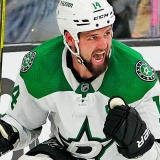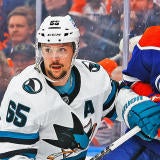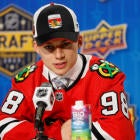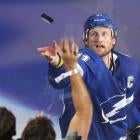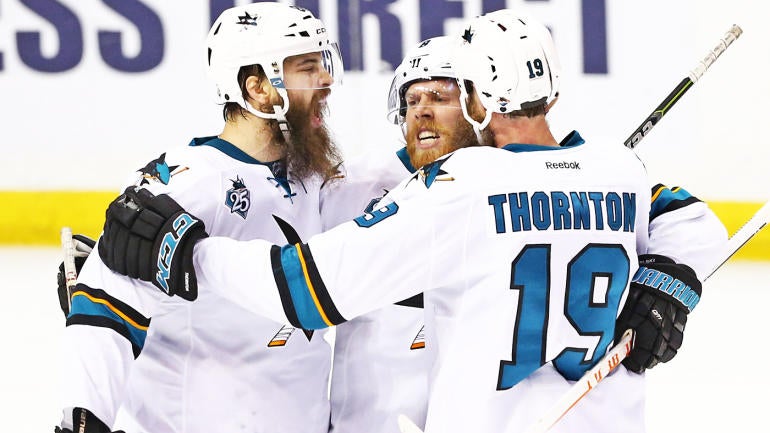
The power play is where the league's best players get their chances to shine in a two-minute period when the ice suddenly opens up and games get broken open.
But even the man advantage can't be a one-man show. A group of five players who can serve as a productive power-play unit is worth its weight in gold. When teams are fortunate enough to cultivate such a crew, they tend to hang on tight, so any list of top power-play units is sure to feature a number of squads that ranked prominently last season.
The emergence of a new generation of young stars may change the balance of power here considerably in the next few years, but for now, the elder statesmen still rule when the opposition's down a man.
The Sharks were the only team to top 60 power-play goals last season, and they're in position to improve even further. Not only are they returning all nine of their most significant power-play contributors, they also added a potential upgrade to their second unit by bringing in former New Jersey point man David Schlemko in the offseason. Veteran forwards Joe Thornton, Joe Pavelski and Patrick Marleau all finished in the top 17 in power-play production last year, but the straw that stirs the drink is defenseman Brent Burns. The blue-line sniper was one of just four players to reach 30 points with the man advantage, using his rocket slapshot to pot seven goals while dishing out 23 helpers as the lone defenseman on a top unit that also includes talented forward Logan Couture (when healthy). That fivesome is as dangerous as any in the league, but any defense that manages to fend off the top unit can't risk letting its guard down against San Jose's B team, which boasts three double-digit power-play point producers from a year ago in Schlemko, fellow blueliner Marc-Edouard Vlasic and power forward Joel Ward.
Backstrom-to-Ovechkin is a tried-and-true power-play formula that should once again keep Washington among the NHL's elite. While the Caps' efficiency dropped to fifth last year after three straight seasons in the top two, the Russian captain still led the league in power-play goals with 19 while the Swedish center led the league with 27 power-play assists. Their supporting cast isn't too shabby, either. Breakout star Evgeny Kuznetsov finished third on the team with 18 points, while newcomer TJ Oshie's 11 goals with the extra man tied for 15th in the NHL. John Carlson and Matt Niskanen are no prime-era Mike Green at the points, but they should once again be entrusted with important roles after managing 14 and 16 power-play points, respectively.
Last season's most efficient power play has all the ingredients it needs for a repeat performance. Veteran linemates Corey Perry and Ryan Getzlaf will both be back after carrying this unit in 2015-16, with both bouncing back from down years to reach 20 power-play points for the sixth and ninth time, respectively. The star sniper and setup man are complemented by a capable blue line that includes Cam Fowler, Hampus Lindholm and Sami Vatanen, who all chipped in 15-plus points. Long-time Canucks centerman Ryan Kesler has also proven capable of getting his own regardless of whether he joins the duo on a devastating top unit or provides balance by skating with the second team, accruing 10 goals and 16 assists on the man advantage in his first two seasons as a Duck. While the engines behind Anaheim's success are on the downsides of their careers, their excellent chemistry reduces the chance of a dramatic downturn.
4. Dallas Stars
It's no surprise that a Stars team that employs Jamie Benn and Tyler Seguin finished fourth in power-play efficiency last season, and they should have no problem repeating that feat as they return all five members of their elite top unit. Jason Spezza, Patrick Sharp and breakout blueliner John Klingberg make up the rest of that fearsome fivesome; each finished with at least 22 points in 2015-16 while all four forwards lit the lamp a minimum of seven times. Benn should be in line for another elite campaign after pacing that group with 17 power-play goals and tying for second in the NHL with 30 points, but the drop-off between the A team and the B team is still a concern. Nobody else on the roster last season managed more than seven points with the extra man, and Dallas didn't bring in any major difference-makers in that regard over the offseason.
Chicago rode Patrick Kane's Art Ross campaign to a meteoric rise in the power-play rankings, moving up from 20th to second. While some regression could be expected if Kane falls short of last season's team-leading 17 goals and league-leading 37 points with the man advantage, there's reason to believe this team will remain among the NHL's best with the extra man. Much of that hope is tied to Artemi Panarin, who helped facilitate Kane's monster campaign both at even strength and on special teams. The Russian winger finished second among Chicago forwards with 24 power-play points as a rookie, and an improved sophomore season could help offset any regression in Kane's level of play. Top defensive pairing Brent Seabrook and Duncan Keith are both still around after topping 15 power-play points in consecutive seasons, but production should be scarce outside of those four main sources. No other Blackhawks player managed more than 10 points with the extra man, and that will likely be the case once more for this top-heavy team unless captain Jonathan Toews supplants the less-skilled Artem Anisimov on the Kane unit.
Philadelphia tied for sixth with 53 power-play goals last season despite getting just one from Jakub Voracek. Much of that success was due to the emergence of rookie defenseman Shayne Gostisbehere, who dismantled opposing penalty killing units with eight goals and 14 assists in just 64 games. If Voracek returns to the form that saw him net 27 power-play goals in his previous three seasons, the Flyers will have an embarrassment of riches to throw at the opposition with those two plus Claude Giroux, Wayne Simmonds and Brayden Schenn. Simmonds and Schenn scored 13 and 11 power-play goals, respectively, last year, while Giroux put up a team-leading 27 points for a grand total of 160 over the past five. The combination of elite passing, shooting and net-front presence found in that group makes Philadelphia's power play a nightmare to defend against.
The Blues' power play has finished among the top seven for three straight seasons, and the departure of David Backes is unlikely to change that. While the former captain's net-front presence will be missed, the Blues still boast a treasure trove of assets that includes one of the league's deadliest snipers and an elite power-play quarterback. Vladimir Tarasenko has gotten more productive in each of his first four years, and last season's 12 power-play goals give him 28 in that span. Despite last season's success, the Russian still came up two points short of Kevin Shattenkirk's 26. That's par for the course for the blueliner, who's put up a monstrous 77 points over the last three years, and his presence is why Blues fans can rest easy regardless of who else gets minutes with the man advantage. The newly acquired David Perron should help ease the pain of Backes' departure, while Alex Steen, Paul Stastny and Troy Brouwer will also be factors after breaking double digits in power-play points a year ago. If they want to go from good to great, though, the Blues will need a bounce-back campaign from defenseman Alex Pietrangelo, who managed just five power-play points in 2015-16 after averaging 17 over the four prior full seasons.
Nobody would accuse the Sabres of having a good season in 2015-16, but the third-worst team in the Eastern Conference didn't reach that level of futility because of the power play. Buffalo's 12th-ranked outfit was just 0.8 percent shy of breaking into the top 10, and things should get even better this year with the addition of Kyle Okposo and the continued development of the team's young core. Last season's edition had three players finish over 20 power-play points, and it's not hard to imagine 25-year-old Ryan O'Reilly, 19-year-old Jack Eichel and 21-year-old Rasmus Ristolainen all improving on that output. Add in Okposo, who's coming off a career-high 23 power-play points with the Islanders, along with continued improvement by Sam Reinhart (who potted eight man-advantage markers in his rookie year), and you have the makings of a power play that should be elite for years to come. Veterans Matt Moulson and Tyler Ennis are both coming off underwhelming seasons, but have proven capable of contributing in past years, and controversial forward Evander Kane also possesses the skill to augment the young core - at least, when he can stay focused and on the ice.
The Panthers were a terrific five-on-five team last season, but finished a disappointing 23rd at 16.9 percent on the power play. They made great strides to address that issue in the offseason, signing veteran Keith Yandle to man the point alongside 2014 first overall pick Aaron Ekblad. Yandle presided over an excellent Coyotes unit that finished fourth in 2013-14 and seventh in 2014-15, then helped a Rangers franchise that hasn't sniffed the top 10 since its Jaromir Jagr days a decade ago finish a respectable 14th. Speaking of Jagr, he returns after being one of seven Panthers to reach double-digit power-play points a year ago. Every member of that club will be back, led by 20-year-old Aleksandr Barkov, who's coming off a team-high nine goals and 16 points. Improved blue-line play will be key to helping a rising young forward corps realize its full potential on special teams, especially if Ekblad takes the next step after totaling nine goals and 13 assists on the man advantage through two NHL seasons. Potential beneficiaries of a higher conversion rate also include the returning Nick Bjugstad, Vincent Trocheck, Jonathan Huberdeau, Jussi Jokinen and Reilly Smith.
Even without many high-profile players, the Devils still managed to finish ninth in the NHL with a 19.9 percent power-play conversion rate last season. While point man David Schlemko has taken his talents to San Jose after contributing 12 points with the man advantage last season, newly added star winger Taylor Hall should more than offset that loss after registering four goals and 12 points of his own for a middling Edmonton unit. Sniper Michael Cammalleri should also make a positive impact after missing half of last year with a hand injury, but the Devils' success will ultimately hinge on breakout star Kyle Palmieri's ability to replicate his team-leading 11 power-play goals and 12 assists from a year ago. They still lack the talent to make a significant climb in the rankings, but this well-coached team will be tough to knock out of the top 10 after finishing there in each of the past three seasons.


